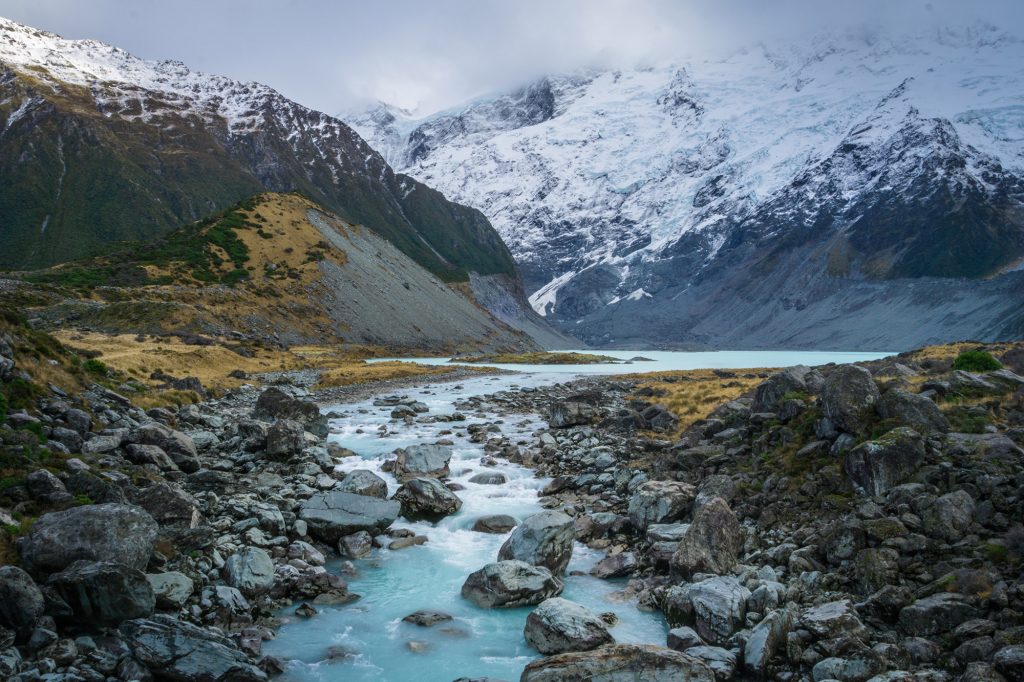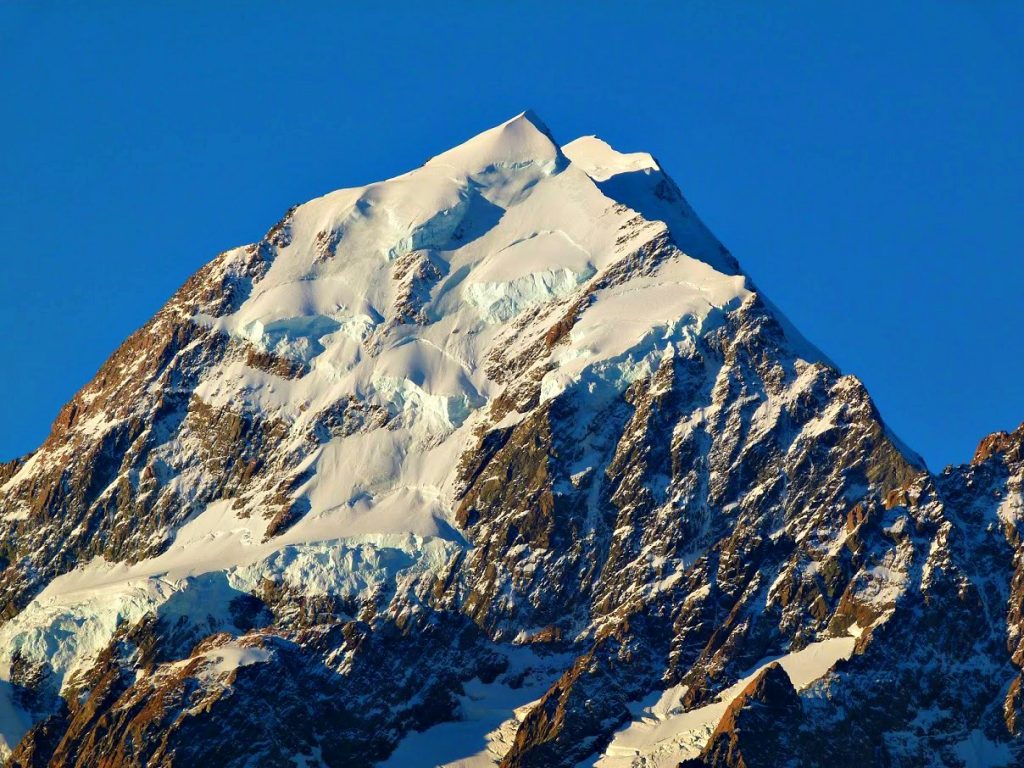Ever since The Lord of the Rings trilogy was filmed in New Zealand, most people automatically think of the films when the country is mentioned, and for good reason. The nation of New Zealand, which consists of a majestic north and south island, plays a vital role in the films and was chosen as the backdrop to The Lord of the Rings because of its awe-inspiring natural beauty.
Although The Lord of the Rings movies show you the splendour of the country’s landscape, then don’t show you when to visit New Zealand, aka Middle Earth. New Zealand is located in the Southern Hemisphere, so the seasons are reversed from the Northern Hemisphere; i.e., when it is winter in, say, England, it is summer in New Zealand. Also, keep in mind that the weather on New Zealand’s North Island and South Island can greatly differ, so when it is the best time to visit Auckland on the North Island, it could be the worst time to visit Dunedin near the bottom of the South Island.
There really is no wrong time to visit New Zealand, but certain times of the year are better than others, depending on the place and activity. For example, if going to New Zealand to snow ski or snowboard, winter is the best time to visit, remembering that winter down under is from June through August, and the North Island is rainier during these months, while the South Island is colder but drier. If you’re going to just lounge on the beach, summer is the best time to visit New Zealand, summer here being December-February and the North Island being the subtropical region.
Table of Contents
The Beach
Obviously, the best time of the year to go to the beach anywhere in summer. But what is the best beach? In New Zealand, that beach can be found at the Bay of Islands, located at the very top of the North Island, which the locals call the “Winterless North.”
The temperature in this subtropical paradise ranges between 72-80 degrees, which is ideal beach weather, and rarely drops below 60 degrees, so you can take your chances at these pristine and undeveloped beaches any time of year. But what if you’re a surfer and coming to just ride the waves and wondering when to visit New Zealand? According to The Perfect Wave, there is a huge difference between the seasons.
During the summer months New Zealand experiences calmer conditions, yet from December through April also receives tropical storms from the Pacific that can produce epic swells. Winter, however, experiences huge southerly storms in Antarctica that produce large, long-period ground swells along the east and west coasts. If on the South Island, one of its best beaches lies in Abel Tasman National Park, Awaroa, aka “The People’s Beach.” This once privately held piece of paradise is so sacred and beautiful that a group of New Zealanders banded together to buy it and then gifted it to the country’s Department of Conservation to keep it open to the public.
Auckland
Auckland is the largest city in New Zealand and receives a big amount of visitors year-round. According to TripSavvy, Auckland’s subtropical climate is characterized by warm, humid summers and cool, wet winters. It is also one of New Zealand’s warmest and sunniest cities.
If your New Zealand itinerary includes Auckland or its surroundings on the north part of the North Island, you should schedule your trip from March to May or between September and November, as the days are typically sunny and mild and the crowds thinner. If you come from December through February, peak summer months in New Zealand, the weather might be hot and humid and the crowds intense, not to mention hotel rooms will be more expensive. January is usually the hottest month of the year. And if you want to brave the crowds and summer heat, February is the best time to hit the beaches here. Conversely, July is the coldest month of the year here, as well as the wettest.
Wellington
The weather in Wellington, New Zealand’s capital city, is often windy and cold, as it is located in the Roaring Forties and is in fact one of the world’s windiest cities. Despite being on the North Island too, Auckland has a better climate than Wellington, as the capital city is located on the south coast along the Cook Strait, one of the most dangerous waters in the world.
The weather in Wellington is often referred to as “inconsistent,” with some Kiwis even going so far as to call it one of New Zealand’s “worst weather cities,” and claiming it doesn’t even have a summer. So, if you’re coming to the North Island of New Zealand for the beaches, your best bet is to head north to the Auckland area. Fortunately, Wellington is not only the capital of New Zealand, but the country’s capital of culture and cuisine, so there is plenty to keep you occupied indoors, such as visiting the WETA Workshop, which helped create the magic behind The Lord of the Rings and The Hobbit movies, including props and costumes; sampling a cornucopia of tasty treats along Hannah’s Laneway, Wellington’s foodie Mecca; and riding Wellington’s historic cable car up the hill to Kelburn Lookout, where you can take in the entire city.
However, that’s not to say Wellington doesn’t have its sunny days. The hottest month here is January, but even then the temperature doesn’t usually rise above 64 degrees. The windiest month is October, with average wind speed at 17 mph. The coldest and wettest month is July, with the typical temperature being around 50 degrees. If you do happen to catch a warm and sunny day in Wellington, head to one of the area’s stunning beaches, such as Makara Beach, Island Bay Beach, Lyall Bay Beach for surfing (if the waves are up, it doesn’t matter if it’s sunny or not) or Worser Bay Beach, one of the most kid-friendly beaches around Wellington.
Nelson
Although located across Cook Strait on the top of the South Island, Nelson, which is protected by Tasman Bay, has weather that is almost the opposite of Wellington. In fact, Nelson has some of the best weather on the South Island, which allows visitors to take advantage of all the ample outdoor activities in the area. This includes Abel Tasman National Park, which has some of the most awe-inspiring natural scenery in New Zealand, including golden beaches, granite cliffs and the world-renowned Coast Track, one of the best hikes anywhere; Gardens of the World, which is six acres of native and exotic plants from around the globe; and the Natureland Zoo, where you can see an array of animals in natural settings.
Like Wellington, Nelson does get some wind, but nowhere near as much as the capital city. However, in Nelson, you can take advantage of the wind via Vortex Wind Karting, which is like “sailing a land yacht.” You can catch the breeze on these carts with sails and cruise along tranquil Tasman Bay. Summer in Nelson is nice and comfortable. The warm season generally lasts from mid-December to late March, with January being the warmest month, but temperatures rarely rising above 77 degrees. During summer in Nelson, the average temperature is around 68 degrees, which is the best time to visit. Late May to early September sees cooler weather, with average daily temperatures hovering around 56 degrees and considerable rain, particularly in May.
Christchurch
Heading southeast down the South Island, your next logical stop is Christchurch, otherwise known as the “Garden City,” which is the third-largest city in New Zealand and one of the country’s most visited places. Christchurch is characterized by a temperate maritime climate but also sees significant rain, especially in July, which is also its coldest month. Like much of New Zealand, the warmest month in Christchurch is January, with February not far behind.
If you are here during the warmer summer season, when average temperatures are around 72 degrees, head outside to the Christchurch Botanic Garden, which is home to a vast array of flowering gardens, native trees, New Zealand blooms and numerous plant conservatories; or go boating on the Avon River, which winds its way through the city and out to the Pacific Ocean.
If visiting in the winter months, when temperatures cool down and range from 52 to 59 degrees, with strong chances of rain, take advantage of Christchurch’s warmer and drier options, such as taking a ride on one of its revered heritage trams, which will take you on a guided tour of the city’s best landmarks; or catch a performance at the Isaac Theatre Royal, New Zealand’s only operational Edwardian-style theatre.
Queenstown
Queenstown, which is inland and southwest of Christchurch, is a resort town on the South Island. It is the adventure capital of the country, enticing outdoor enthusiasts from around the world. Many even refer to Queenstown as the “Adventure Capital of the World.” But outdoor adventure in Queenstown, which lies on the shores of Lake Wakatipu and set against the majestic Southern Alps, is not limited to warmer spring and summer months.
In fact, countless people come here specifically in winter to ski and snowboard, as Queenstown is a renowned winter destination. Ski and snowboard season runs from late June to mid-October, depending on snow levels. The best peaks in the area and the best times to ski or snowboard on them include The Remarkables, July 4 to September 27; Coronet Peak, June 26 to September 27; Cardrona, June 26 to October 18; and Treble Cone, June 27 to September 6.
If you prefer spring and summer, fear not, as there are more outdoor activities in Queenstown during these months than you could possibly do in one trip, such as bungee jumping (Queenstown is the site of the world’s first permanent commercial bungee operation), hiking, rock climbing, mountain climbing, mountain biking, whitewater rafting, river surfing, jet boating on a river, canyon swinging, zip-lining, skydiving, hang gliding, paragliding and much more.
Average summer temperatures in Queenstown are between 68 and 77 degrees, perfect for being outdoors and not too hot. Keep in mind that December, which is summer here, is the wettest month in Queenstown.
Dunedin
Dunedin lies near the bottom of the South Island, and its weather can be vastly different than that on the North Island as well as a lot of places on the South Island. For example, summers are cooler here, winters are short and quite cold and it is frequently windy and cloudy.
December, even though summertime, sees the most rain in Dunedin, whereas January is the warmest month, with an average high temperature of only 66 degrees. July is the coldest month, with average temperatures of 50 degrees, and it has been known to snow here.
Dunedin is also so southerly that you can even see penguins here, particularly on the Otago Peninsula at aptly named Penguin Place. Although there are picturesque beaches in the area, including St. Clair Beach, Dunedin isn’t exactly known as a beach holiday destination. Instead, Dunedin is well-known for its striking Edwardian and Victorian architecture, which can be explored year-round, and as New Zealand’s oldest university city. The city’s top tourist attraction is Larnach Castle, the only castle in the country, which is open to the public.
If you really need to get outside, despite what time of year and what the weather is doing, head to the Dunedin Botanic Garden, home to 6,800 different plant species; Taiaroa Head at the tip of Otago Peninsula, where you will find the Royal Albatross Centre and a colony of little blue penguins at nearby Pilots Beach; or wind-lashed Tunnel Beach, whose magnificent sandstone cliffs make for a mystical seaside hike.









Leave a Reply